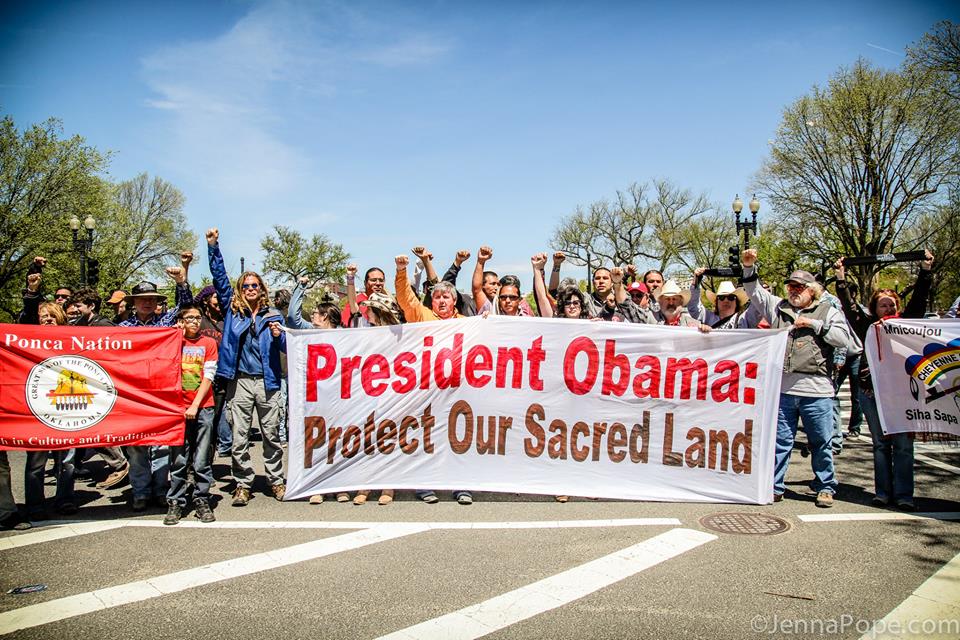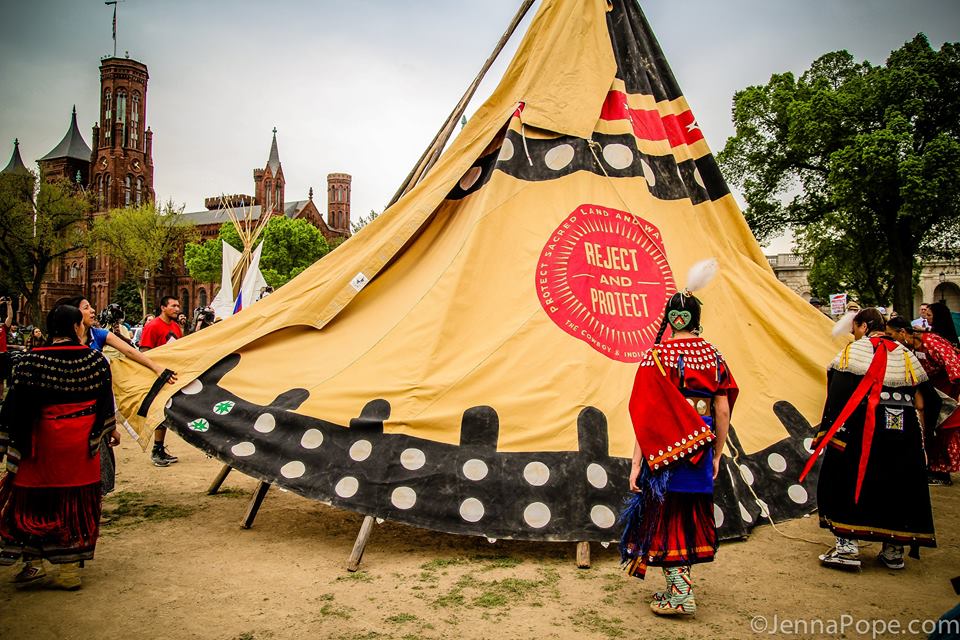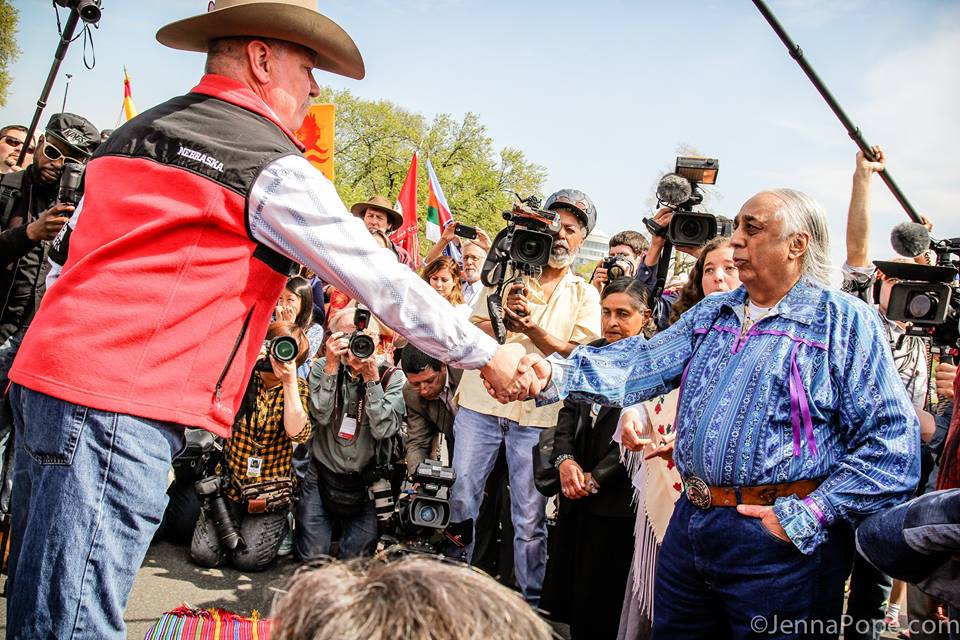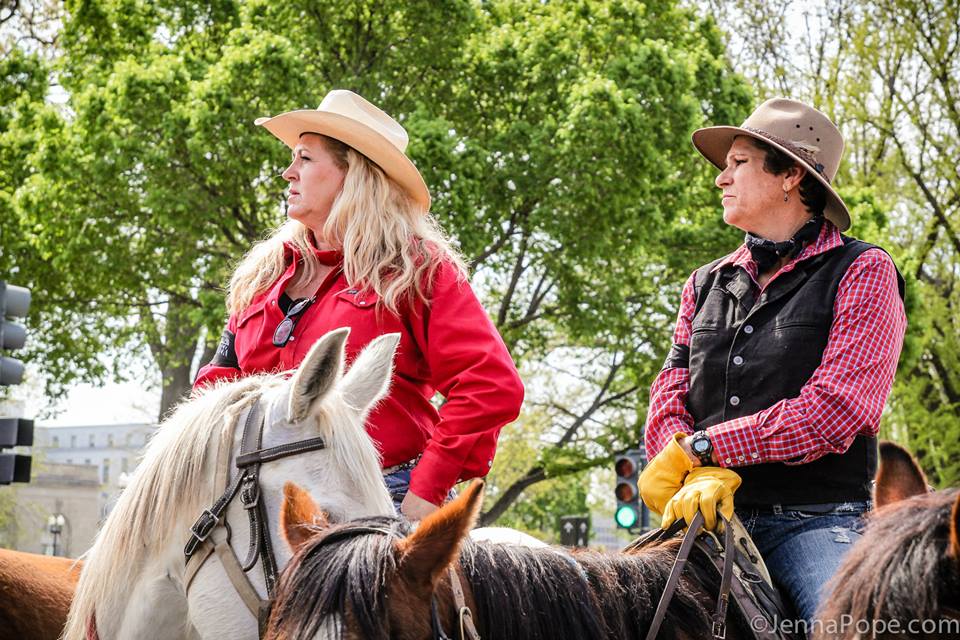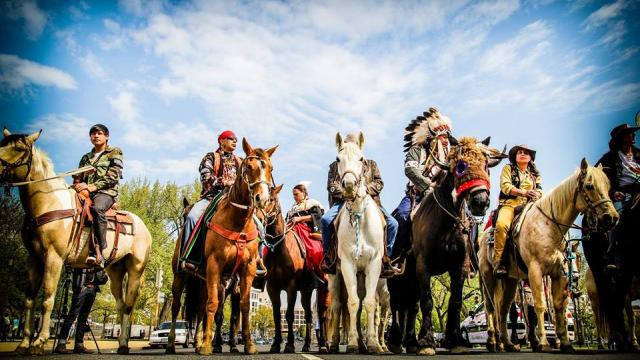
Jenna Pope
"We are living the nightmare," Casey Camp of the Ponca Nation, from North Central Oklahoma, tells me on the National Mall in D.C. "We live in the shadow of ConocoPhillips and several other aggressive polluters. The initial Keystone (pipeline) was going through Ponca territory before we had a chance to say yes or no. Other indigenous people from Canada had already told me about the Tar Sands and the devastation that was occurring there – I could relate to it because our homeland was going through the ravages of the environmental devastation from the extraction industries."
It is Saturday, April 26, and we are sitting in the volunteer tent of Reject And Protect, an encampment established by the Cowboy Indian Alliance, which rode into the nation's capital one week ago to demand that the U.S. government reject the Keystone XL pipeline.Thousands have just participated in a rally and march on the National Mall, joined by Neil Young, Darryl Hannah and Ed Schultz. But unlike many protest actions I have attended in the past, you can feel something different – and it's not the celebrities.
On Monday of last week, as indigenous activists were about to raise six tipis on the National Mall, a sacred fire was lit in this encampment. Simultaneously, two fires went up in two separate camps that have been erected in the path of the proposed pipeline, forging a connection between the Reject And Protect encampment on the National Mall and the spiritual camps out West. Last Tuesday, during the opening ceremony after gifts were exchanged, a traditional water ceremony was performed at the reflecting pool of the U.S. Capitol Building.
"The spiritual ground and what is inside of it is water. Water is what is inside of you. When you are in your mothers womb you are in water. When it breaks you move into the world," said Tribal President Scott of the Redbud Sioux Tribe. He continued, "Water is the giver of life."
The proposed route of the pipeline would pass directly over the Ogallala Aquifer, one of the largest aquifers and freshwater sources in the world, which stretches from South Dakota to Texas under portions of eight states. Justin Song Hawk of the Yankton Sioux Tribe said, "It's not about if it breaks, but when it breaks. They say they can clean it up, but they use chemicals to clean it up, all of which would remain in the drinking water."
A Winding and Uncertain Road
The latest turn in the Keystone pipeline saga occurred on Friday, April 18, when the U.S. State Department indefinitely delayed the permitting process for the pipeline while awaiting the outcome of litigation in Nebraska. The controversy surrounding the permitting of the Keystone XL had flared up on the last Friday in January when the State Department released its long awaited Environmental Impact Statement (EIS).
Unsurprisingly, the report claimed that the project would have no adverse environmental impact. Environmental activists across the country sprang into action and in three days managed to organize some 300 vigils in 44 states to voice dissent against what appeared to be the impending approval of the project. The release of the final draft of the EIS initiated a 90-day National Interest Determination process, consisting of a 30-day public comment period followed by a 60-day review by eight federal agencies. After this last hurdle, President Obama would be free to approve the controversial project – and activists feared the flawed EIS had paved the way.
The public comment period began February 5 and organizers worked tirelessly to collect people's comments. On March 2, 398 students zip-tied themselves to the fence in front of the White House in an action titled XL Dissent, while promising that there would be more to follow. By the time the public commenting period ended on March 7, the State Department had received, according to its own description, an “unprecedented” 2.5 million comments. Not only that, but an activist pledge to engage in civil disobedience if Keystone was approved had surged to 95,000 signers. XL Dissent began organizing campus trainings to prepare students to engage in civil disobedience. Further attention was drawn to the issue on April 17 when San Francisco billionaire Tom Steyer and his PAC, NextGen Climate Action, pledged to spend up to $100 million to make the KXL a primary issue in the fall elections.
Upon learning several weeks ago that the government was once again delaying its decision on Keystone, many activists saw it as a sign that the tide may be turning, once and for all, against the project. However, mixed with optimism was a clear recognition that more still needed to be done to create the political will forcing an out-and-out rejection of the pipeline. Bill McKibben wrote in EcoWatch, "We need to keep building the movement, and we need to keep putting heat on leaders like President Obama till we win, not delay the decision on the Keystone XL pipeline."
A recent Rasmussen poll reported that 61% of likely voters currently support building the Keystone XL. Facing the deep-pocketed public relations machines not only of TransCanada and Big Oil, but also the government of Canada, environmental activists have had to turn to more clever and striking ways to get the anti-Keystone message out. Last weekend's Reject And Protect action led by the Cowboy Indian Alliance was the latest effort by ranchers, farmers, indigenous leaders and other activists to refute the corporate spin that a pipeline carrying tar sands crude through the heartland of America – posing massive risks of spills while dramatically boosting carbon emissions while not even providing people here with jobs – was somehow a good thing.
Bold Nebraska and the Cowboy Indian Alliance
In May of 2010, Jane Kleeb founded the group Bold Nebraska to organize around progressive issues in Nebraska. The group wasn't initially involved in anything environmental, but at one point Kleeb accepted an invitation by the Nebraska Wildlife Federation to attend a hearing on a proposed Tar Sands pipeline. "I didn't even know what Tar Sands was," said Kleeb, but at the meeting she was touched by the knowledgeable ranchers who were testifying about the potential dangers of the Keystone XL pipeline. At the end of the meeting, Kleeb told her friend: "We are in."
Soon after, Faith Spotted Eagle, a Yankton Sioux tribal elder, invited the group of ranchers and farmers being organized by Bold Nebraska to a meeting with indigenous activists. As the indigenous activists taught them about the intricacies of issues surrounding Treaty Rights, the ranchers and farmers couldn't help but see parallels in their own fights over eminent domain.
In 2011, as the Cowboy Indian Alliance was forming, Kleeb received an email from 350.org encouraging people to come to Washington DC to be arrested at the White House while voicing dissent against the Keystone pipeline. For Kleeb and many other members of Bold Nebraska, this action would be a pivotal moment as they came to realize that their local fight suddenly had international ramifications. The action also cemented the relationship between Bold Nebraska, 350.org and the budding Cowboy Indian Alliance.
Spiritual Camps and Crop Art
After teaching for 35 years, Art Tanderup retired to the family farm that had been in his wife's family for over 100 years. The Tanderups grow corn, soybeans and rye. They hope to pass the farm on to their children. But almost two years ago, while working out in the field, Art received a phone call from his wife telling him to come to the house: there was a representative of TransCanada waiting to see him. The representative delivered Tanderup with a waiver that allowed the pipeline to pass through the family's land, offering them a hard sell. By the time the pitch was over, recalled Tanderup, it seemed "if you wouldn't sign right then, then you were unamerican."
But the Tanderups politely told the representative that they would do their own research before allowing the pipeline to pass through their land. "I have done more research than it would take to get a doctorate degree," joked Tanderup, and in the process what he found was a "rude awakening." Tar Sands pipelines, he discovered, are a relatively new technology – and the land he hopes to leave his children will be a guinea pig for this new technology.
The toxicity of the Tar Sands, as well as the fact that the proposed route includes a bend on his property, led Tanderup to realize he had to dig his heels in and say no. "This thing is so important to us that we are ready to take it to the end," he said.
Part of Tanderup's land is on the Ponca Trail of Tears, and last year Art and his wife invited indigenous activists to set up a spiritual camp on the land. They established tipis and performed ceremonies to honor their ancestors, the water, the land and the future generations for which they steward these resources.
"Culturally, everything starts with a prayer, but as the things begin to happen, things begin to change, we say thank you," explains James Weston of the Flange Saintee Sioux. "All of the cultures have the seed to remember that all of the things that happen occur because of the creator and say thank you," Weston continued.
"The non-native people take on the legislative mentality of the fight. All the processes that need to be followed, the legalities... Not that we don't, but god the creator comes first in everything we do."
The cultural differences presented some difficulties to the otherwise linear organizing style of Jane Kleeb. "The tribes are way more laid back, which sometimes presents scheduling and logistical challenges," said Kleeb. "Sometimes we fight like brothers and sisters, but we also love like brothers and sisters."
Earlier this year, intentions to bring a spiritual camp to the National Mall in DC began to materialize into a concrete plan. 350.org, looking to escalate the campaign against the Keystone pipeline, provided logistical support to the groups' organizing effort. The spiritual grounding that the indigenous activists brought to the campaign – and the striking visuals of a tipi encampment on the National Mall populated by actual Cowboys and Indians – would, they hoped, provide a final push for Obama to reject the pipeline. Prior to the State Department's announcement earlier this month of an indefinite delay on its decision, Bill McKibben characterized Reject And Protect as "possibly the final stand."
Rediscovering the Sacred
Environmental activists often point out that all people of this world share the same environment and are interconnected – but somehow the message has fallen flat, failing to galvanize a radical solidarity movement needed to confront the ecological disaster of climate change. Without an appreciation of the sacred resources we consume, and a gratitude for the privilege of having clean water and air, we will be separated not only from the environment we rely on but also the people and species we share the Earth with.
Indigenous activists are right to point out that it's only by reclaiming the word, sacred, from religion – by creating a secular identification of the interdependence between our environment and the life that it supports – that we may create the radical solidarity and political will necessary to confront the challenge of abandoning fossil fuels. With indigenous activists in the lead, it is time to start deconstructing the long narrative of separation and start swaying public opinion so that we may finally begin to take the actions necessary to avert catastrophic climate change.
Indigenous activists had gathered water from the Ogallala Aquifer prior to the encampment at Reject And Protect, and every morning this water was honored and returned to the earth on the National Mall to open the day's activities. The Sacred Fire was tended and burned the entire seven days of the encampment. Prayers, offerings and the smell of burnt sage abounded in the shadow of the U.S. Capital Building and the Washington Monument.
On Friday, April 25, an Interfaith Prayer Service was held in front of Secretary of State John Kerry's house; on Sunday, another service was held in front of the White House. Honoring the sacred took precedent over all other activities at the encampment, and by the weekend a pristine energy had imbued the camp and the attendees of the rally with a spiritual grounding unlike any action I have ever experienced.
"To me it is all really simple and basic," continued Casey Camp of the Ponca Nation. "If one wakes up, the sun rises, you drink the water, you breathe the air, and you have the realization that you are intricately connected with all that is. I think that [Reject And Protect] has been successful in the areas that matter. The connection between the human beings here and the identification of the interconnectedness is like the tide rolling in: one wave after another of this new understanding rolling ashore."
Gary Roland was an early organizer at Occupy Wall Street where he helped form the Legal Activist Working Group, Labor Outreach Committee and OWS Facilitation. He later participated in Occupy Sandy relief efforts and is currently organizing a new campaign, Occupy Your Breath. Follow him @NYCCamp.
3 WAYS TO SHOW YOUR SUPPORT
- Log in to post comments

